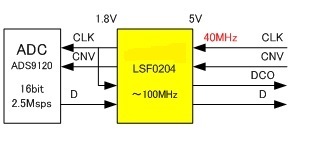Other Parts Discussed in Thread: ADS9120, TXB0104
Hello.
Does LSF0204 have the specification of "Channel-to-channel skew"?
I use LSF0204 as shown below.
In order to connect with the ADS9120, it is necessary to secure setup time and hold time.
For example,
TXB0104 has the following specification.
SCES650I Page-10
"6.13 Switching Characteristics: VCCA = 1.8 V ± 0.15 V"
Channel-to-channel skew 0.5ns MAX
Regards,
Dice-K


